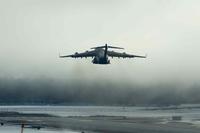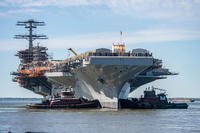The Marine Corps would receive about $25 billion under the Pentagon's fiscal 2016 proposed budget announced Monday that would maintain the Corps' end strength at about 184,000 Marines and put a priority on developing the Amphibious Combat Vehicle.
Under the Defense Department's proposal, the Marines' base budget next year would be about $24 billion plus an additional $1.3 billion from the separate war budget for Overseas Contingency Operations (OCO) for a total of $25.3 billion. Last year's budget approved by Congress for the Marines was $24.9 billion.
The $25.3 billion for the Marines would come out of the $160.9 billion requested by the Defense Department for the Navy.
The Marine Corps will keep the service's current active duty troop levels at about 184,000 in 2016 along with a slight reduction in reserve strength from 39,500 to 39,200. By comparison, the Army is set to lose about 23,000 soldiers due to budget cuts while the Navy and Air Force increase their force numbers.
DoD's overview of the budget said that the $25.3 billion for the Marines "will continue to grow crisis response capability and begins to address readiness issues of its non-deployed forces."
Marine Commandant Gen. Joseph Dunford has put a high priority on the Marines' long-standing request for the development of a new Amphibious Combat Vehicle (AVC) to carry Marines from ship-to-shore in contested areas.
"We will continue to prioritize the fielding of a self-deploying, high speed amphibious combat vehicle, that will meet out requirements for the future even as we implement the first phase of the current Amphibious Combat Vehicle Program," Dunford said recently.
The Marines were expected to award two manufacturers a contract to build the first 16 ACV prototypes by the end of this year. The long-range plan was to buy 200 ACVs and put them in service by 2023.
The budget also included a boost in funding for the development of the scanned array radar technology for the Marines for air and ground targets. The AN/TPS-80 Ground/Air Task-Oriented Radar (G/ATOR) system would be designed to be hauled by a tactical vehicle.
There was no funding for the G/ATOR system in the FY2014 budget proposal. A total of $89 million was included in the FY2015 budget and that number would go to $131 million in FY2016.
There was also a major boost in Marine investment with the Army in the Joint Land Tactical Vehicle program to replace the Humvee. The Marine investment in JLTV development would go from $8 million in FY2015 to $89 million in FY2016.
Under the Pentagon's budget proposal, Dunford has also outlined what has been described as a "back to the future" plan for a redirection in how the three Marine Expeditionary Forces (MEFs) are organized and deployed.
Dunford's planning guidance issued Jan. 23 would have I MEF based at Camp Pendleton, California, put a priority on major operations while II MEF based at Camp Lejeune, N.C., would focus on crisis response at the brigade level.
The Japan-based III MEF, with most of its Marines on Okinawa, would stay "regionally oriented" for the rebalance of forces to the Pacific and III MEF headquarters would be upgraded to a standing joint task force headquarters under the U.S. Pacific Command.
"The desired end state is the effective employment and support of assigned, allocated, and apportioned Marine Corps forces," Dunford said in 16-page guidance that has been described as a move back to how the Marine Corps operated before the Sept. 11, 2001 terrorist attacks. The plan "will set the conditions to fight and win against future enemies," Dunford said.
Another focus of the plan will be to have the Marines work more closely with the U.S. Special Operations Command dominated by the Army.
-- Richard Sisk can be reached at richard.sisk@military.com


























